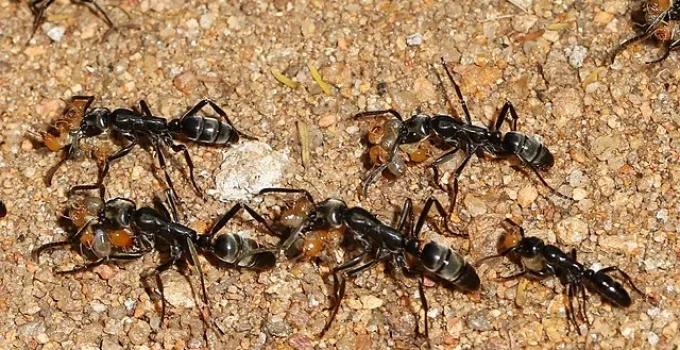Do Ants Eat Termites?
Ants do eat termites. Ants are the natural enemies of termites. Most ant species eat insects, both living and dead, including termites. In fact, the Matabele ant (Megaponera analis) of sub-Saharan Africa, one of the largest ant species in the world, eats nothing but termites. Interestingly, an ant can’t eat a termite directly. Termites are fed to ant larvae which digest and dissolve it into liquid form for adult ant consumption.
What Else Eats Termites?
Ants aren’t the only predators that the termite has to avoid. Termites are an important food source for many amphibians, reptiles, birds, spiders, other insects, and even a few mammals.
- Amphibians such as frogs, toads, and salamanders eat termites. The Peter’s dwarf frog (Engystomops petersi), a terrestrial amphibian species found in the forest of Amazonian Columbia, Ecuador, and Peru, subsist solely on termites.
- Many reptiles eat termites as well. Termites make up a portion of the diets of lizards, chameleons, and even some snakes. In fact, the common worm snake can often be found in the nests of termites so that they can readily feed.
- Many spiders will also eat termites. Termite-eating spiders include members from the Salticidae, Zodariidae, Theridiidae, and Ammoxenidae families. Interestingly, members of the family Ammoxenidae eat only termites, which is why they are commonly called “termite hunters.”
- Many birds love to feast on termites. The woodpecker hammering away at the tree is delighted to find termites that have burrowed beneath. Unfortunately, they will also hammer away at your home if you have a termite infestation! The Southern Anteater-Chat likes to set up shop next to groups of termite hills for easy daily access to its meals.
- A few mammals feast on termites as a regular part of their diets. Insectivorous bats are predators of the termite as well as the armadillo. Yup, the odd little mammal, the armadillo, is also a predator of the termite. It eats a diet of ants, termites, maggots, beetles, and worms.
What Else Do Ants Eat?
Ants are not a finicky bunch. Depending on the species, an ant’s diet can consist of other insects, both dead and alive, meats, sweets, and honeydew.
Carpenter ant: The carpenter ant sticks to the basic diet of insects, meats, sweets, and honeydew. Though the carpenter ant does not eat wood, it chews it into sawdust to tunnel through.
Cornfield ant: Eats a very basic diet of insects, sweets, and honeydew.
Field Ants: Simple diet of insects, sweets, and honeydew.
Larger Yellow Ant: Subsists on honeydew.
Pavement Ants: Feed on insects, meats, sweets, bread, and pet food.
Pharaoh Ants have a decidedly interesting sense of taste. The pharaoh ant will eat greasy, fatty foods, sweets, dead insects, and oddities such as soap and toothpaste.
Thief Ants: Eat greasy, protein foods, including peanut butter, nuts, meats, and cheeses. They Will eat sweets. Likely named for their small size and ability to enter almost any container.
References
- Wheeler, William Morton (1936). “Ecological Relations of Ponerine and Other Ants to Termites”. Proceedings of the American Academy of Arts and Sciences. 71 (3): 159–243
- Extension Service – “A Fire Ant Smorgasbord.”
- Funk, W. C.; Angulo, A.; Caldwell, J. P.; Ryan, M. J.; Cannatella, D. C. (2008). “Comparison of morphology and calls of two cryptic species of Physalaemus (Anura: Leiuperidae)”. Herpetologica. 64 (3): 290–304
- United States Department of Agriculture Forest Service – “Common Worm Snake”
- https://www.fs.usda.gov/detail/elyunque/learning/nature-science/?cid=stelprdb5274052
- Petrakova, Lenka, et. Al. Nature.com – Scientific Reports – “Discovery of a monophagous true predator, a specialist termite-eating spider (Araneae: Ammoxenidae.”
- The Cornell Lab of Ornithology – All About Birds – “Why Do Woodpeckers Like to Hammer on Houses . . .”
- The Cornell Lab of Ornithology – eBird – “Southern-Anteater-Chat.”
- Grapevine Animal Services – “Common Wildlife.”
- University of Minnesota Extension – “Ants.”
📌Learn More About Ants
- How Do Ants Reproduce?🐜A Deep Dive Into Colony Growth
- Do Ants Have Blood?🐜 The Surprising Truth about Insect Circulation
- Can Ants Smell? 🐜 Exploring the Chemical World of Ant Communication
- Can Ants Swim? 🐜 Exploring the Aquatic Abilities of Earth’s Hardest Workers
- Do Ants Eat Termites? 🐜 The Many Termite Predators
- Do Ants Have Brains? 🐜 Inside the Mind of Nature’s Minature Engineers
- Do Ants Have Muscles? 🐜 Explore What These Muscular Powerhouses Can Do
- Do Ants Sleep? 🐜 Ants Are Supersonic Power Nappers!
- How Long Do Ants Live? 🐜 A Look Into the Lifespan of the Colony
- What Do Ants Eat? 🐜 Inside the Pantry of an Ant Colony
- Are Ants Blind? 🐜How These Tiny Insects See the World
